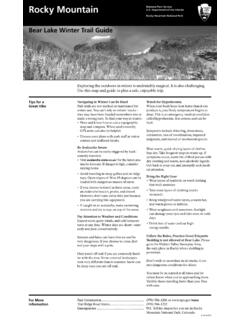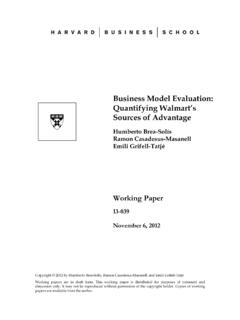Transcription of DOLPHIN EXPLOITATION AND SUFFERING AT SEAWORLD …
1 INTRODUCTIONIn 2016, SEAWORLD announced that it would end its orca-breeding program after facing mounting criticism from scientists and the public over its poor treatment of captive orcas (Howard, 2016). Since this announcement, however, the company has continued to breed bottlenose and Pacific white-sided dolphins the orca s smaller cousins and house them in small, concrete tanks, as well as exploiting them in archaic, circus-style performances and interactive programs in which they re touched, grabbed, and stood on by trainers. In November 2018, a veterinarian observed the captive dolphins held at the SEAWORLD parks in San Diego, San Antonio, and Orlando. Evidence obtained from those observations revealed that the well-being of captive dolphins at the parks is severely compromised by the conditions in which they re forced to live.
2 This includes an astonishing number of dolphins 140 confined to just seven tanks at four SEAWORLD owned theme parks in the Unites This report provides a glimpse into the miserable lives of these exploited animals, who endure routine physical, psychological, and social stress and at times sustain painful injuries as a result. PEOPLE FOR THE ETHICAL TREATMENT OF ANIMALS | 1 BrewsterDOLPHIN EXPLOITATION AND SUFFERING AT SEAWORLD PARKSH eather D. Rally, Supervising Veterinarian, PETA FoundationToni Frohoff, Behavioral Biologist and Research Director, TerraMar ResearchJUNE 5, 2019 GENERAL CONDITIONSC aptive dolphins at SEAWORLD are housed in severely crowded, extremely shallow, small enclosures that are spatially, acoustically, and visually unnatural to the species.
3 Most have barren concrete walls with bright, reflective surfaces that prioritize maximum visibility and accessibility of dolphins for park visitors over consideration of the animals health and welfare. For example, in SEAWORLD s shallow petting pools, members of the public are permitted direct access to the edge of the pool and are frequently observed harassing the dolphins by splashing and submerging their arms and hands in an attempt to grab and touch the animals. The tanks are devoid of sufficient depth and any natural features, hiding places, or variability that would allow the dolphins to take refuge from conspecifics or the public, creating an environment of inescapable, routine stress (Frohoff & Bekoff, 2018). Confining captive wild animals to small, barren, crowded enclosures causes them physical harm and trauma and can lead to illness and premature death.
4 Studies have shown that far-ranging carnivores, such as dolphins, who would routinely travel long distances in nature, are acutely susceptible to SUFFERING when confined to enclosures like those at SEAWORLD that are just a minuscule fraction of the size of their natural home range (Clubb & Mason, 2003). An extremely small tank at SEAWORLD Orlando labeled the DOLPHIN Nursery held at least 11 full-grown adult bottlenose dolphins. This tank, which is shallow in order to maximize visibility of the animals for park visitors, contains less than one third of the water that an Olympic-sized swimming pool does. Such a space isn t adequate to house a single adult bottlenose DOLPHIN , let alone nearly a dozen of these deep-diving, far-ranging, socially complex mammals. Whether caught in the wild or bred in captivity, dolphins are wild animals who are biologically driven and highly motivated to engage in specific natural behavior that helps them thrive in the ocean.
5 This behavior includes swimming distances of up to 60 miles per day, diving to depths of nearly 1,500 feet, and maintaining dynamic relationships within a large social network (Klatsky, Wells, & Sweeney, 2007; Mann, Connor, Tyack, & Whitehead, 2000). Yet dolphins at SEAWORLD are confined to constrained and injurious environments that are lacking in natural variability, treated with chemicals, and physically restrictive, with depths that are often only marginally greater than the legally required minimum of 6 feet (USDA, 2017), which is wholly inadequate and less than the length of their own STRESSD olphins at SEAWORLD parks are housed in conditions that exacerbate the impact of unnatural and anthropogenic noise on them. Acoustic stress is a serious welfare concern for captive dolphins, who would use their sophisticated acoustic systems to communicate, navigate, hunt, and visualize their environment in the wild with astonishing acuity.
6 Their aural anatomy and physiology is highly complex and exceptionally sensitive to sources of sound and vibration. The DOLPHIN tanks at SEAWORLD parks with their parallel concrete walls, metal gates and latches, and mechanical filtration plants and pumps create an environment that potentiates anthropogenic noise, vibrations, and reverberations from both inside and outside the tank (Couquiaud, 2005). Additionally, at SEAWORLD , dolphins are typically confined either to petting pools, in which they re forced to interact with park visitors, or to performance pools, in which they re forced to perform for audiences, both of which present unique noise insults. Park visitors have been observed tapping, knocking, and even banging on underwater-viewing tank glass at SEAWORLD s DOLPHIN petting pools in an attempt to attract the animals attention.
7 Because of the physical properties of sound propagation in water, such seemingly innocuous behavior can translate into intrusive noise that routinely assaults the animals hearing inside the tanks, creating an acoustic insult that is likely to cause chronic stress. Dolphins in shows were also routinely exposed to large, raucous crowds and loud, amplified music projected from speakers surrounding PEOPLE FOR THE ETHICAL TREATMENT OF ANIMALS | 2their tanks. These noise levels in the air would also be expected to affect dolphins, who must spend significantly more time with their heads above the water for shows than they would naturally in the wild (Rose & Parsons, 2019). A growing body of research has found that exposure to excessive or unnatural levels of noise can affect a number of health and welfare parameters in cetaceans, including immune suppression, increased aggression, and premature hearing loss (Couquiaud, 2005).
8 Indeed, captive dolphins who are exposed to acoustic insults are known to demonstrate physiological and behavioral indications of stress, such as an increase in circulating stress hormones and a refusal to perform or eat. Captive dolphins have even died because of severe acoustic disturbances (Couquiaud, 2005; Monreal-Pawlowsky et al., 2017).SOCIAL STRESSA nother factor that is known to have a dramatic effect on captive dolphins health and well-being is acute or chronic social stress. Dolphins are highly social, with an impressive capacity for emotion as well as self- and social-awareness. Their complex social networks include intimate, sometimes lifelong relationships between individuals and dynamic affiliations among groups ranging over wide areas (Waples & Gales, 2002).
9 Yet dolphins at SEAWORLD continue to be housed in artificial social groups. Given the cramped living conditions that they re chronically kept in, it s no surprise that aggression among them appears to be commonplace. The dolphins used in theatrical performances and human-interaction programs are required to perform tricks for a food reward of dead fish. During a performance at the San Diego location, two dolphins aggressively chased, tail-swiped, and bit at each other while trainers encouraged them to pose for a photograph with members of the public and allowed the park visitors to feed them by hand. This incident not only placed the public in danger but also exposed the fact that SEAWORLD s practice of baiting captive dolphins to perform tricks for food rewards contributes to heightened aggression and social tension among them.
10 Indeed, many of the dolphins at SEAWORLD were observed with rake mark injuries and scars, which are parallel, linear wounds sustained when dolphins are bitten by conspecifics while swimming. In the wild, aggressive encounters between dolphins can dissipate when a subordinate animal retreats from an aggressor, but in captivity, dolphins can t escape from aggressive attacks. This, coupled with the fact that captive dolphins often demonstrate unnaturally heightened levels of aggression in captivity as a result of stress or deprivation, results in excessive raking incidents. PEOPLE FOR THE ETHICAL TREATMENT OF ANIMALS | 3 Indeed, at SEAWORLD parks, some of the dolphins were observed with extensive rake mark lesions across their entire bodies, supporting the conclusion that aggression is commonplace among them.







